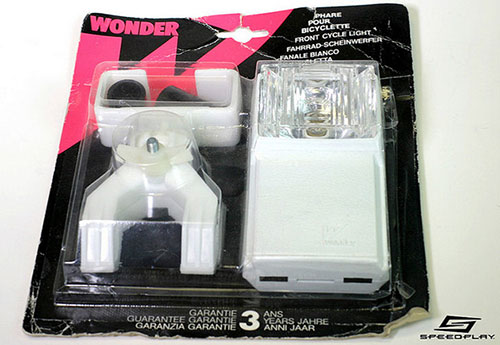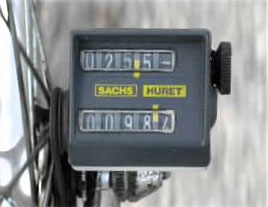The '60s & '70s: The Good Old Days
by John Neugent
Tech articles | Commentary articles |
The late John Neugent probably knew more about bicycle wheels than anyone else. Maybe more about bikes as well. He spent his life in the bike business, at every level. He owned Neugent Cycling, a firm devoted to delivering world-class equipment at the lowest possible price. —Chairman Bill

Author John Neugent

The bike business of the ’60s and ’70s was entirely different from what it is now. I will take you back to see how much different it was. I was a partner in a bike shop in ’73 but my first 10 speed was bought in the late ’60s. I commuted to work on it. It was the height of the bike boom and I went to the only shop in town. Miles Rogers sold bikes and lawn mowers out of his garage and he sold me a Triumph (made by Raleigh in England) with Huret derailleurs. The freewheel was a 5 speed 14-20, the chainrings were 49/52. The reason for the tight gearing was the derailleurs couldn’t handle wider spreads. So the claims that you had 10 gears was factually true but the internal 3 speed hubs of the time had a much wider range.
In the early to mid ’60s, the vast majority of the business was in juvenile bikes. Adult bikes really only took off in any volume when the bike boom hit. When I got into the business in ’73 there were no American magazines that covered the sport. Even Velonews, at that time, was Northeast Cycling News and was distributed to USCF members. There were no mail order companies in the bike industry. Bike shops were much more concerned about mass merchants than anything else.
There really was nothing to read that followed the sport in a meaningful way. Luckily, I was dating a girl whose parents were in France and they would mail copies of Miroir Du Cyclisme.

A rare and cherished magazine for a '70s bikie.
Racing was very localized and there were no Mountain Bikes or BMX bikes. The only good mechanics manual was Glenn’s manual that came out in the early ’70s. I was pretty much self-taught. I learned wheel building by trial and error. We had bought a good quantity of Mirella bikes that came equipped with sew-up wheels and I had to build clincher wheels for pretty much every sale. You might call that a good chance to learn wheel building.
Our local race scene was pretty good. We “sponsored” three Connecticut State Champions, one New England Champion, and one National Champion who all lived around our shop. The first person I saw with a real race jersey and shorts was in 1974. Good cycling clothing was all wool. Helmets were yet to be invented. Bell Biker Helmets were invented in 1979. Racers sometimes wore the old leather helmets.

This is what passed for a helmet back then. Picture: Speedplay Museum
Technology has also changed. In the early ’70s, the first thing we did when adjusting front derailleurs was to bend the side of the cage inward at the front. It was about 5 years before the derailleur makers started doing that on all of their derailleurs. Maybe one of the best features of one of the lower end derailleur bikes was done by Ross who put steel chainguards on both the inner and outer front chain rings preventing the chain from falling off even when the derailleur was out of adjustment. It made kid's bikes pretty much kid-proof. I wonder why a lighter version of that is not in use today.
It should be noted that in the ’60s and even into the ’70s there were bike shops who didn’t like derailleurs. They felt internal gear hubs were the better solution. Raleigh salesmen had to know how to assemble and disassemble Sturmey-Archer 3-speed hubs. I learned how to service internal hubs and it was good that I did since they needed it often.
Most 10 speed bikes came with “safety levers” which were anything but. They attached to the brake hoods and were extensions following the handlebar so you could apply the brakes without moving your hands. When even out of adjustment a little bit they pretty much didn’t work.

Gone, but not forgotten, safety levers.
Then there was the Wonderlight. Which was aptly named because it was a wonder it worked at all. But it was easy to mount and remove.

A Wonder Light from the 1970s. Picture: Speedplay Museum.
Small computers, of course, didn’t exist and the analog units were heavy and clumsy so most serious riders used the Huret Multito which mounted on the front axle. The good local racers would mainly monitor their effort by time – something some of the top riders do to this day. The logic is that miles can either be easy or hard, but if you put out a strong effort you have a better sense of how much work you did.

A Huret Multito from the '70s. Photo: Sheldon Brown
With all of the changes over the decades one thing has not changed. It’s the feeling of riding a bike (although that is also changing with the introduction of E-bikes). I totally support E-bikes because I believe it will get more people on bikes. If someone gets interested in a sport I think there is always a progression that has to start somewhere.
John Neugent was was one of the first to establish quality hand building in Taiwan around the turn of the century. He now owns Neugent Cycling, a firm devoted to delivering world-class equipment at the lowest possible price.








